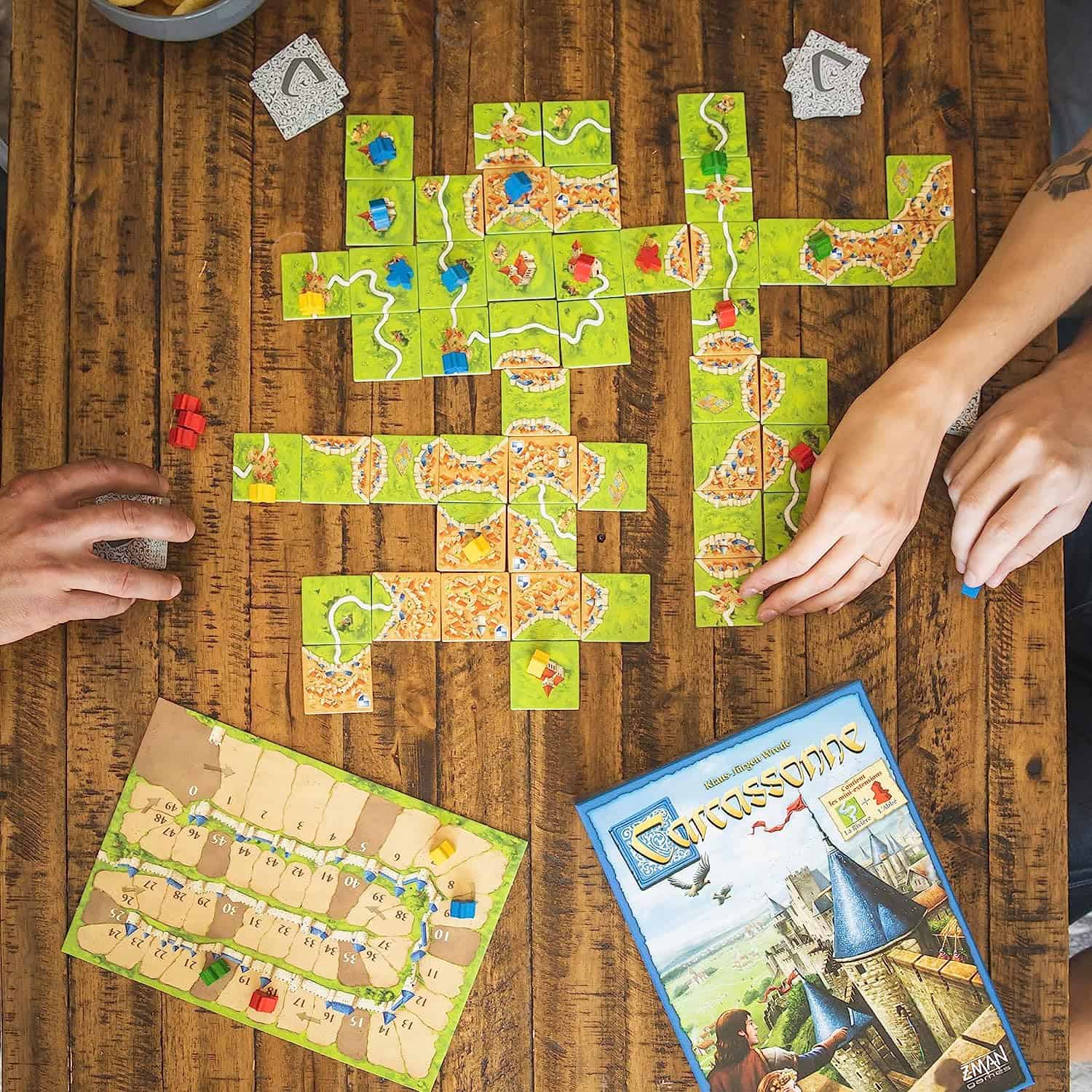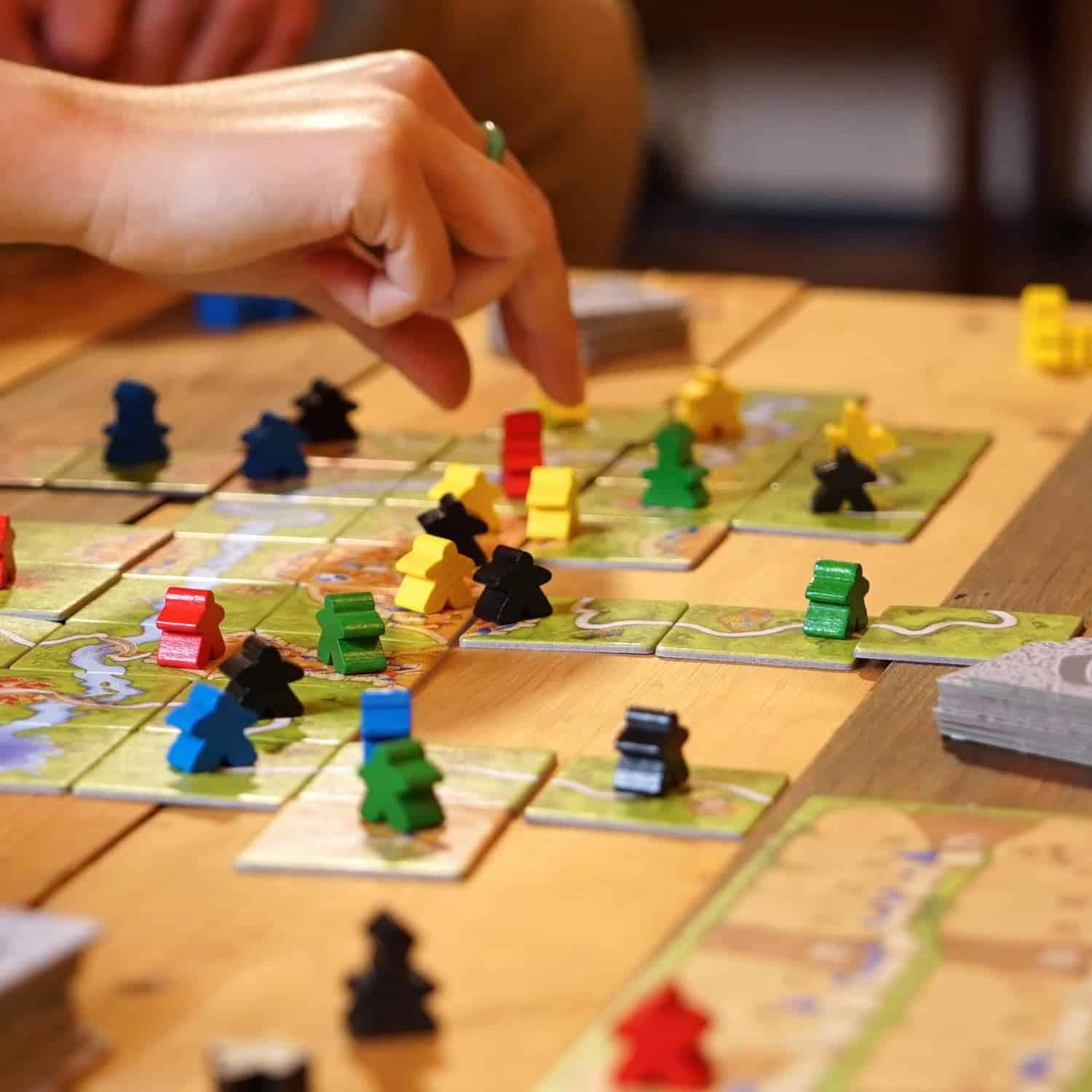Every boardgame site always has a review or how-to-play for Carcassone, and not surprisingly, this article will focus on an in-depth guide to this whimsical game.
In the world of Carcassonne, where medieval landscapes are created one tile at a time, players embark on a journey filled with sheep, knights, and strategically placed thieves. It’s like playing medieval land-planning Tetris, but with castles, roads, and cheeky farmers.
The game begins with a quaint countryside, but it quickly turns into a cutthroat competition as knights jostle for control of epic castles, bandits attempt to hijack cities, and farmers claim their turf (literally).
Victory depends on mastering the art of subtle treachery. Will your sneaky monastery placement complete your opponent’s city or finally provide that much-needed road to freedom? Only time will tell. So grab your meeples, fortify your sense of humor, and remember, it’s all fun and games until someone steals your city.
What’s included in Carcassone

- A set of landscape tiles with different features (cities, roads, fields, and monasteries).
- A scoring track.
- A set of meeples (more on this later) in different colors.
- A starting tile (with a central feature).
How to play Carcassone

The goal of Carcassonne is to score the most points by strategically placing tiles and deploying followers, known as meeples, on various landscape features.
Setup
- Place the starting tile face-up in the center of the playing area.
- Shuffle the remaining tiles and create a draw pile.
- Each player chooses a color and takes all the meeples of that color.
- Place the scoring track nearby and set all players’ scoring markers to zero.
- Decide who goes first (usually the youngest player), and play proceeds clockwise.
Gameplay
Carcassonne is played over a series of turns, with each player taking the following actions on their turn:
- Draw and Place a Tile: The active player draws a tile from the draw pile and places it adjacent to one or more existing tiles, ensuring that landscape features (roads, cities, fields, etc.) on the tiles match up seamlessly. Tiles must be placed so that their edges align with the edges of existing tiles.
- Optional: Deploy a Follower: After placing a tile, the active player may choose to deploy a follower (meeple) onto a feature of the newly placed tile. The rules for deploying meeples are as follows:
- Cities: Meeples can be placed inside city tiles as knights. They score points when the city is completed.
- Roads: Meeples can be placed on roads as highwaymen. They score points when the road is completed.
- Fields: Meeples can be placed in fields as farmers. They score points at the end of the game based on completed cities adjacent to the field.
- Monasteries: Meeples can be placed in monasteries as monks. They score points when the eight tiles surrounding the monastery are filled.
- Scoring: Features (cities, roads, monasteries) are scored when they are completed. A feature is considered complete when it is fully enclosed (for cities and monasteries) or has endpoints on both sides (for roads). At that point, the player with the most meeples in that feature scores points equal to the number of tiles comprising the feature. If multiple players have meeples in the same feature, they each score the same number of points. Fields are scored at the end of the game, earning points for each completed city adjacent to the field.
- Retrieve Meeples: After scoring, the player retrieves their meeples from completed features and returns them to their supply.
- Draw a New Tile: The active player replenishes their hand by drawing a new tile from the draw pile. The draw pile should always contain four tiles.
- Pass Turn: Play passes to the next player clockwise.
End of the Game: The game ends when the last tile is placed. At this point, players score any remaining uncompleted features on the board, including fields. The player with the most points wins. In the case of a tie, the player with the most meeples remaining in their supply breaks the tie, and if there is still a tie, the tied players share the victory.
For the official rules, see the link below:
How to win
- Complete Cities: Completing cities can yield a substantial number of points. If you have control over a city, focus on enclosing it as quickly as possible. Deploy meeples in cities that you can realistically finish.
- Extend Roads: Roads are the easiest features to complete, and they score consistently throughout the game. Extend your own roads and disrupt opponents’ road networks by placing tiles that make it difficult to connect.
- Monasteries and Fields: Monasteries can provide a quick influx of points when completed, and fields can yield significant endgame points. Use meeples wisely in these features.
- Farmers: Farmers are a long-term investment. Place them in fields that have the potential to encompass multiple cities. They can provide a massive point boost at the end of the game.
- Blocking Opponents: Prevent opponents from completing their features whenever possible. For example, place a tile that makes it difficult for them to complete a city or road.
- Strategic Meeple Placement: Be cautious about overcommitting meeples to a single feature. While they can score big, they can also get trapped. Keep some meeples in reserve for future opportunities.
- Expansion Tiles: If you’re using expansion tiles, understand their unique features and plan your strategy accordingly. Expansion tiles introduce new scoring opportunities and strategies.
- Adapt to Opponents: Pay attention to what your opponents are doing. If you see someone heavily investing in a feature, consider competing with them for control or blocking their progress.
- Balance Risk and Reward: Sometimes, it’s better to play conservatively and secure smaller points consistently rather than risking everything on a single feature.
- Endgame Scoring: Keep an eye on the endgame scoring opportunities, especially for fields. Consider the cities and roads adjacent to fields when deciding where to place farmers.
- Late-Game Tile Placement: In the late game, try to place tiles that help you complete features or maximize points. Avoid creating new, uncontrolled features that could benefit opponents.
- Timing: Timing is crucial. Consider when to close features and when to leave them open for later scoring opportunities.
- Meeples in Hand: Having meeples available is crucial for opportunistic placement. Don’t overextend early in the game; save some meeples for key moments.
- Study the Board: Continuously assess the board and look for opportunities to score points. Be flexible and adapt your strategy as the game unfolds.
- Collaborate and Compete: In multiplayer games, consider collaborating with opponents when it benefits both parties. For example, you can share control of a large city for mutual gain, then compete for it later.